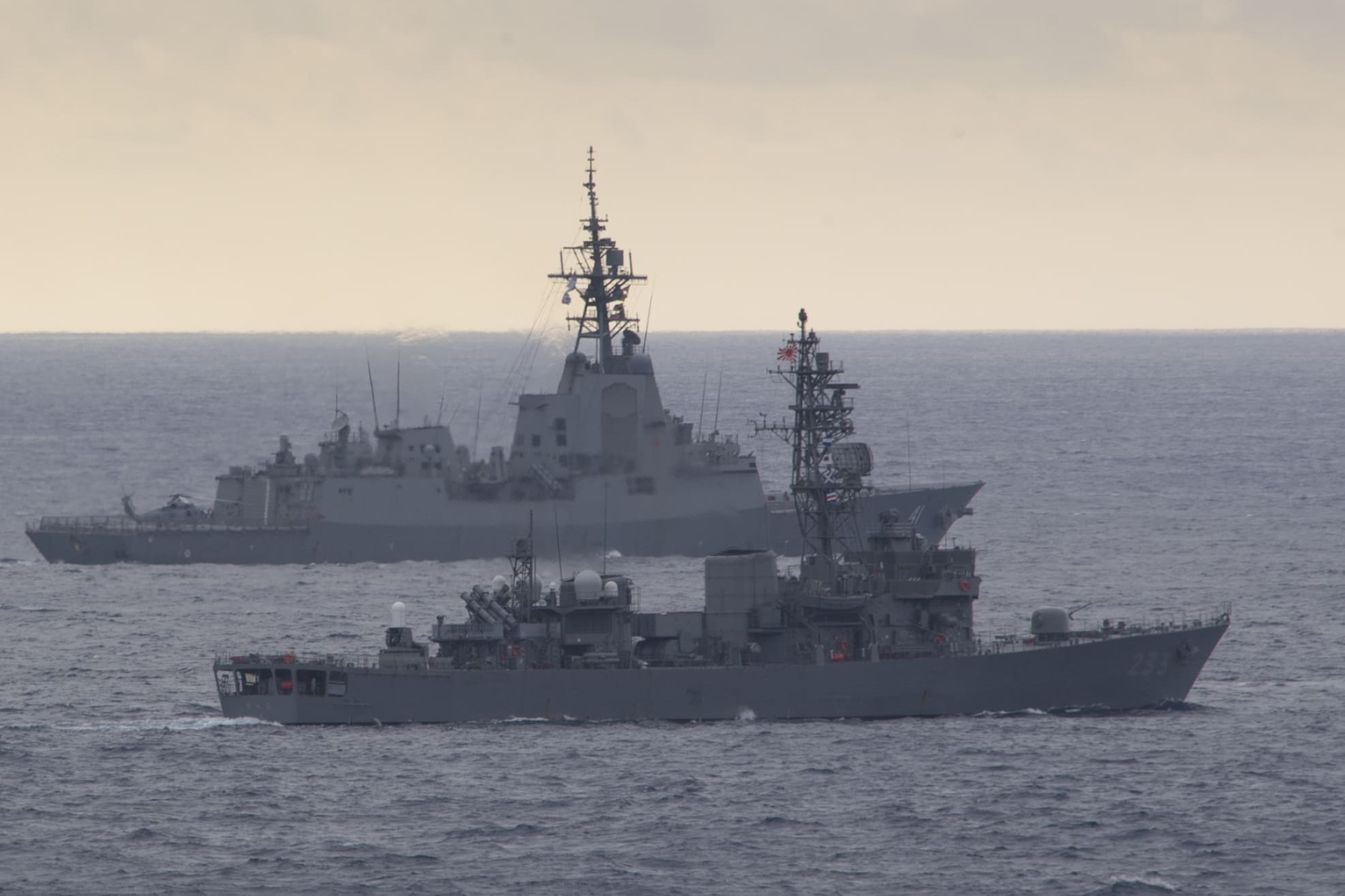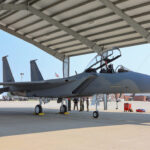Tokyo and Manila are negotiating the transfer of six Abukuma-class destroyer escorts and additional Beechcraft King Air TC-90 maritime surveillance aircraft. Philippine Navy chief Vice Adm. Jose Ma. Ambrosio Ezpeleta says discussions started after Japan signaled its plan to retire the 35-year-old ships.
Defense officials on both sides confirm the talks are active but stress that a formal offer has not yet been issued.
Philippine Navy Modernization Plans Gain Momentum with Japanese Warship Transfer
According to industry sources, Japan’s Maritime Self-Defense Force (JMSDF) would release the destroyers between fiscal 2026 and 2027, when the newer Mogami-class enters full service.
The Philippines seeks at least five hulls, subject to a Joint Visual Inspection (JVI) this summer in Kure.
The same delegation will review surplus TC-90 airframes now held in reserve by Fleet Air Wing 5 at Tokushima.
Abukuma-Class Destroyer Characteristics:
- Full-load displacement: ~2,550 t
- Length: 109 m
- Beam: 13.4 m
- Propulsion: CODOG with two Kawasaki-built Spey gas turbines plus two diesels
- Primary sensors: OPS-20 early-warning radar, OQS-5 bow sonar
- Armament: one 76 mm gun, eight Type-90 anti-ship missiles, ASROC launcher, Phalanx CIWS
- Crew: 120 officers and sailors
The Philippine Navy has no destroyers in commission today; its largest vessels are two José Rizal-class frigates.
Anti-Submarine Warfare Capabilities to Expand Philippine Navy Reach
Accepting Abukumas would give Manila a dedicated anti-submarine platform with embarked helicopters, expanding patrol range beyond the 12-nautical-mile territorial limit and into its exclusive economic zone. Our analysis shows that even after service life extension, each ship can operate another 15 years with moderate investment in combat system refresh and hull corrosion work.
Five JMSDF TC-90s donated in 2017 and refitted with commercial FLIR systems now log 2,200 flight hours per year out of Sangley Point.
Manila wants three more airframes to create a second maritime patrol squadron and shorten maintenance downtime. Similar regional initiatives, such as the recent sale of 22 Guardian drones to India, show the growing demand for long-endurance surveillance capabilities across Asia. Defense officials confirm that basic airframe life remains above 11,000 hours, well within design limits.
Defense Equipment Transfers Under Japan’s Three Principles Framework
Japan’s 2014 Three Principles on Defense Equipment Transfer permit exports only when the recipient supports regional stability. Cabinet sources indicate the destroyer hand-over will be framed as a “joint capability enhancement program,” allowing upgrades such as a new combat management system to be classified as co-development.
Manila must still secure funding. The Department of Budget and Management has flagged ₱38 billion (≈ $650 million) for Fleet Modernization Horizon-3, but only ₱7 billion is earmarked for surface combatants this year. This allocation is part of a broader Philippine Navy modernization program that also includes advanced combat aircraft acquisitions.
Japanese Warships for the Philippines: Funding and Support Considerations
Additional financing may come from Japan’s Official Security Assistance (OSA) window, which covers non-lethal equipment but can offset training and logistics costs.
If the agreement moves forward, the first Philippine crew will enter JMSDF Destroyer Escort Transition Training in Yokosuka early 2026. The syllabus runs 32 weeks and covers machinery, combat systems, and damage control. A follow-on Mobile Training Team will deploy to Cavite to certify local instructors. According to a Philippine naval staff study, conversion costs – including tropicalized air-conditioning, NATO Sea Sparrow removal, and datalink integration with the José Rizal class – should stay under ₱2.1 billion per ship.
Beijing’s coast guard continues to shadow Philippine resupply missions at Second Thomas Shoal.
Tokyo faces parallel pressure over the Senkaku Islands. Both governments signed a Reciprocal Access Agreement last month; it will let Japanese units rotate through Philippine bases for disaster response and joint drills.
Analysts note that forward-basing JMSDF P-1 patrol aircraft in the Visayas could follow once runway extensions finish in 2026. Such presence would complicate any single-actor coercion in the Luzon Strait.
Projected timeline:
- July 2025 – Joint visual inspection of hulls 1-6 and airframes in Japan
- November 2025 – Signing of transfer memorandum and OSA support package
- April 2026 – First Philippine crew class begins in Yokosuka
- Q4 2026 – Ship 1 dry-dock refit completes at Sasebo; sea trials start
- Early 2027 – Formal hand-over of first two destroyers at Subic
- Mid-2029 – All accepted hulls achieve initial operational capability
Philippine Navy Ships to Boost West Philippine Sea Endurance
An Abukuma escort can remain on station in the West Philippine Sea for eight days without replenishment – twice the endurance of the current Del Pilar-class cutters. The new airframes would raise daily maritime patrol coverage by 27 percent, reaching nearly 90,000 square nautical miles.
That uplift allows the Philippines to sustain surface presence in Reed Bank while keeping a quick-reaction pair closer to Palawan. It also frees José Rizal frigates for deterrence patrols around Scarborough Shoal.
Manila has yet to decide whether to retain the Mk 32 torpedo tubes or replace them with the South Korean K-745 Blue Shark system. Procurement officials say price and commonality will drive the choice.
Tokyo must, in turn, secure Diet approval for the ships’ export classification. Parliamentary debate could focus on whether the destroyers’ sonars count as “offensive” under domestic law.
Japanese Warships Export: Precedent for Southeast Asia Security Policy
Even with those caveats, planners in both capitals treat the transfer as the most cost-effective way to improve Philippine anti-submarine warfare coverage before 2030. The destroyers give Manila a hull-mounted sonar, a close-in weapon system, and a flight deck able to support its future H145M maritime helicopter – all in one package.If concluded, the Abukuma deal would mark Japan’s first export of a complete surface combatant since the Second World War and would move the Philippine Navy beyond a frigate-centric force structure. More important, it sets a precedent for Tokyo’s broader security assistance policy in Southeast Asia. Each side gains: Japan strengthens a frontline partner without deploying its own combatants permanently, while the Philippines closes a critical capability gap at minimal cost and risk.
REFERENCE SOURCES
- https://www.reuters.com/world/asia-pacific/japan-pm-push-security-economic-ties-philippines-visit-2025-04-29/
- https://www.reuters.com/world/china/japan-export-used-destroyers-philippines-deter-china-yomiuri-reports-2025-07-06/
- https://www.navalnews.com/naval-news/2025/07/japan-in-talks-to-transfer-warships-surveillance-aircraft-to-the-philippines/
- https://www.japantimes.co.jp/news/2025/07/07/japan/politics/japan-philippines-used-destroyers-china/
- https://www.defensemirror.com/news/39815
- https://www.manilatimes.net/2025/07/08/news/national/navy-confirms-possible-transfer-of-destroyers/2144921
- https://www.philstar.com/headlines/2025/07/07/2456099/philippines-talks-japan-acquire-warships
- https://news.ssbcrack.com/japan-in-talks-with-philippines-for-transfer-of-used-navy-destroyers-and-surveillance-aircraft/
- https://www.abs-cbn.com/news/nation/2025/7/6/ph-navy-to-inspect-japanese-destroyer-escorts-for-possible-transfer-2213
- https://www.newsweek.com/japan-philippines-news-navy-ship-transfer-china-maritime-disputes-2095418
- https://www.maritime-executive.com/article/japan-may-give-philippine-navy-a-major-boost
- https://english.kyodonews.net/articles/-/56792
- https://www.scmp.com/week-asia/politics/article/3313460/japan-philippines-military-drills-become-reality-after-tokyo-ratifies-defence-pact
- https://globalnation.inquirer.net/279565/fwd-on-ph-japan-raa-approval
- https://www.pna.gov.ph/articles/1251648



